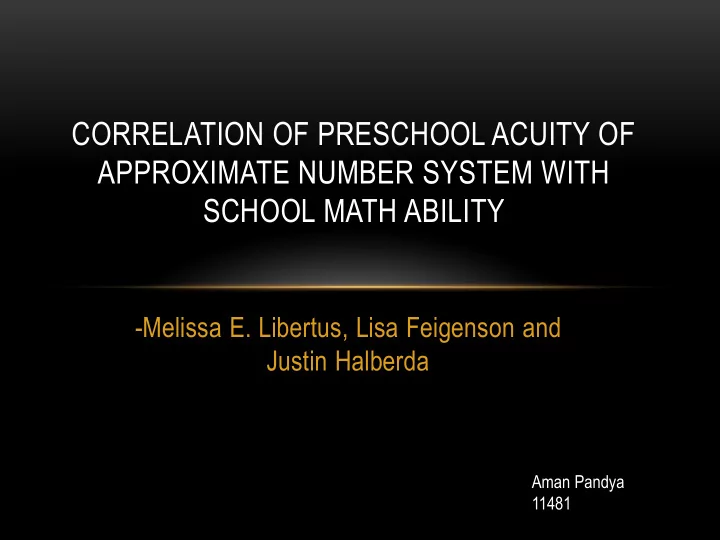

CORRELATION OF PRESCHOOL ACUITY OF APPROXIMATE NUMBER SYSTEM WITH SCHOOL MATH ABILITY -Melissa E. Libertus, Lisa Feigenson and Justin Halberda Aman Pandya 11481
INTRODUCTION • Individual differences in math abilities present from earliest years of formal learning. • Differences due to social factors and cognitive capacities. • Recent focus also on possibility of unlearned number skills.
APPROXIMATE NUMBER SYSTEM (AMS) • A cognitive system that relies on estimation of magnitude. • Present right from childhood and precision improves with age. • Independent from language and other acquired number symbols. • Intraparietal sulcus found to be the neural locus of ANS.
• ANS supports quantitative computations. • Performance at computing over ANS representations follows Weber’s Law. • WEBER’S LAW: Difference between two stimuli proportional to magnitude of stimuli. • Experiments with 14 year olds shows ANS acuity correlates with math ability.
• Several experiments relate ANS to math ability even in younger ages. • Booth and Siegler’s number line experiment. • But these also require processing of number symbols and not entirely ANS.
AUTHOR’S EXPERIMENT • Conducted on 200 3 to 5 year olds. • Included ANS acuity tasks and tests on math and verbal abilities. • Results prove ANS acuity correlates with early math abilities.
• Cause of link between ANS acuity and math ability still a question. • A possibility that ANS is fundamental for acquiring numeric symbols. • Less accurate ANS may lead to math anxiety. • Experiment did not control factors such as overall intelligence and information processing. Instead it controlled vocabulary skills which correlate with these.
Thank You
Recommend
More recommend